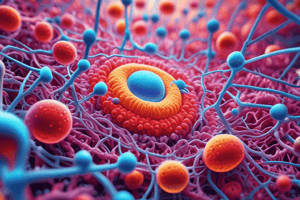Podcast
Questions and Answers
Which of the following best describes 'concentration' as a characteristic of industrial structure?
Which of the following best describes 'concentration' as a characteristic of industrial structure?
- The number and size distribution of firms within a specific market. (correct)
- The minimum cost required to produce a good relative to total output levels.
- The degree to which a firm produces outputs unrelated in the supply chain.
- The obstacles preventing new firms from entering a specific market.
A company that manufactures its own components, assembles the final product, and distributes it through its own retail stores is engaging in which type of industrial structure characteristic?
A company that manufactures its own components, assembles the final product, and distributes it through its own retail stores is engaging in which type of industrial structure characteristic?
- Diversification
- Vertical Integration (correct)
- Economies of Scale
- Horizontal Integration
If a bicycle manufacturer also produces clothing and sporting goods, this would be an example of what?
If a bicycle manufacturer also produces clothing and sporting goods, this would be an example of what?
- Cost Leadership
- Economies of Scope
- Vertical Integration
- Diversification (correct)
Which of the following factors would NOT be considered a barrier to entry for a new firm entering a market?
Which of the following factors would NOT be considered a barrier to entry for a new firm entering a market?
Which perspective views a firm as a collection of assets and liabilities?
Which perspective views a firm as a collection of assets and liabilities?
From a legal standpoint, which structure defines a business owned and run by one person where there is no legal distinction between the owner and the business?
From a legal standpoint, which structure defines a business owned and run by one person where there is no legal distinction between the owner and the business?
What underlying factor connects all characteristics of a firm, such as choice of output, assets, and liabilities?
What underlying factor connects all characteristics of a firm, such as choice of output, assets, and liabilities?
What is the purpose of 'discounting' in the context of business decision-making?
What is the purpose of 'discounting' in the context of business decision-making?
Why is 'structure' preferred over 'size' when discussing firms?
Why is 'structure' preferred over 'size' when discussing firms?
What is the 'optimum-structured firm' defined as?
What is the 'optimum-structured firm' defined as?
Why might two firms operating in the same environment with the same objectives have different structures?
Why might two firms operating in the same environment with the same objectives have different structures?
In the context of price theory, what does 'optimum-sized firm' traditionally refer to?
In the context of price theory, what does 'optimum-sized firm' traditionally refer to?
Under what market conditions does a firm's optimal output align strictly with minimizing unit production costs?
Under what market conditions does a firm's optimal output align strictly with minimizing unit production costs?
In perfect competition, what assumption, coupled with a horizontal demand curve, shapes firm behavior?
In perfect competition, what assumption, coupled with a horizontal demand curve, shapes firm behavior?
Which aspect of a firm's activity reflects the vertical scope of its operations?
Which aspect of a firm's activity reflects the vertical scope of its operations?
What does value added reflect in the context of industrial structure?
What does value added reflect in the context of industrial structure?
What is the primary benefit of categorizing firms into industry subgroups, as opposed to considering all firms as a single economic unit?
What is the primary benefit of categorizing firms into industry subgroups, as opposed to considering all firms as a single economic unit?
What makes defining a precise boundary for an 'industry' challenging?
What makes defining a precise boundary for an 'industry' challenging?
Why is defining an industry solely based on firms producing the 'same product or service' considered too restrictive for most analytical purposes?
Why is defining an industry solely based on firms producing the 'same product or service' considered too restrictive for most analytical purposes?
Considering the entire economy as a single 'industry' is deemed too broad primarily because it:
Considering the entire economy as a single 'industry' is deemed too broad primarily because it:
Besides the 'same product or service' criterion, what alternative basis for grouping firms into industries is suggested in the text?
Besides the 'same product or service' criterion, what alternative basis for grouping firms into industries is suggested in the text?
What fundamental characteristic must be present for a group of firms to be meaningfully classified within the same industry?
What fundamental characteristic must be present for a group of firms to be meaningfully classified within the same industry?
Grouping firms based on 'common processes' is exemplified by classifying together firms that:
Grouping firms based on 'common processes' is exemplified by classifying together firms that:
The text implies that a more comprehensive and practical definition of 'industry' should move beyond simply considering the 'same product'. This suggests incorporating:
The text implies that a more comprehensive and practical definition of 'industry' should move beyond simply considering the 'same product'. This suggests incorporating:
Flashcards
Industrial Structure
Industrial Structure
The characteristics of output from firms, including cost conditions, concentration, vertical integration, diversification, and entry barriers.
Cost Conditions
Cost Conditions
The relationship between minimum production costs and total output levels.
Concentration
Concentration
The number and size distribution of firms in a specific category of output.
Vertical Integration
Vertical Integration
The extent to which different production stages are handled by one firm.
Signup and view all the flashcards
Diversification
Diversification
Producing different types of unconnected outputs by a firm.
Signup and view all the flashcards
Entry Barriers
Entry Barriers
Obstacles that prevent new firms from entering a market.
Signup and view all the flashcards
Decision-Making Process
Decision-Making Process
The method by which a firm's controlling individuals make operational choices.
Signup and view all the flashcards
Present Value
Present Value
The current worth of a future cash flow based on a specific discount rate.
Signup and view all the flashcards
Value Added
Value Added
The difference between a firm's sales revenue and the costs of inputs; reflects the enhancement added to raw materials.
Signup and view all the flashcards
Firm Structure
Firm Structure
The multidimensional concept that reflects the organization and operational aspects of a firm, beyond just size.
Signup and view all the flashcards
Optimum-Structured Firm
Optimum-Structured Firm
A firm structure that effectively achieves objectives better than any alternatives, not just minimizing costs.
Signup and view all the flashcards
Perfect Competition
Perfect Competition
A market structure where the demand curve for an individual firm is horizontal, indicating no market power over pricing.
Signup and view all the flashcards
Sales Revenue
Sales Revenue
The total income received by a firm from selling its goods or services before any costs or expenses are deducted.
Signup and view all the flashcards
Long-Run Average Cost
Long-Run Average Cost
The lowest cost per unit of output when a firm adjusts all its inputs optimally, typically achieved at optimum scale.
Signup and view all the flashcards
Substitutability Criterion
Substitutability Criterion
A principle used to classify firms based on shared product characteristics or interchangeability in outputs.
Signup and view all the flashcards
Industry Grouping
Industry Grouping
The classification of firms producing similar products or services within an economy.
Signup and view all the flashcards
Single-Firm Industry
Single-Firm Industry
An overly narrow definition where only one firm is considered its own industry due to unique outputs.
Signup and view all the flashcards
Economy-wide Industry
Economy-wide Industry
A broad definition including all firms competing for consumer funds across the economy.
Signup and view all the flashcards
Common Processes
Common Processes
Grouping firms based on the similar methods they use to produce goods, like printing and weaving.
Signup and view all the flashcards
Raw Material Usage
Raw Material Usage
Grouping firms by the same resources they consume, such as cotton or iron.
Signup and view all the flashcards
Interindustry Comparisons
Interindustry Comparisons
Analyzing different industries to assess their structures and outputs relative to one another.
Signup and view all the flashcards
Output Characteristics
Output Characteristics
Defining features of the goods produced that are critical in categorizing firms into industries.
Signup and view all the flashcardsStudy Notes
Chapter One: Firms, Objectives, and Industrial Structure
- Industrial Structure: A selection of characteristics of a firm's or group of firms' output, including cost conditions, concentration, vertical integration, diversification, and entry barriers.
- Cost Conditions: The relationship between the minimum cost of producing and distributing a good or service and various levels of output.
- Concentration: The number and size distribution of firms producing a particular output.
- Vertical Integration: The extent to which successive stages in the production of a product or service are performed by a single firm.
- Diversification: The extent to which a firm produces different, unrelated kinds of output.
- Entry Barriers: Obstacles faced by new firms wishing to enter a market. These features are analysed in detail later in the book.
Nature of the Firm's Objectives
- Profit Maximization: A primary objective in economics. Profit is the difference between receipts and costs.
- Economic Profit: The difference between total revenue and the opportunity cost of all inputs.
- Accounting Profit: The difference between total revenue and explicit monetary costs.
- Sales Revenue Maximization: Some firms aim to maximize sales revenue, subject to a minimum profit constraint.
- Managers' compensation can be more tied to sales than profits, leading them to prioritize sales volume.
- Growth Maximization: Growth can be an objective in itself, needing financial resources which often necessitates profits.
Nature of the Firm's Objectives - Discussion of Present Value and Discounting
- Present Value: A way to compare future receipts or payments to their current equivalent value.
- Discount Rate: Reflects the decision-maker's preference for current versus future payoffs, often linked to the rate of return on alternative investments.
Chapter Two: Industry Subgroupings
- Substitutability Criterion: Grouping firms into industries based on the close substitutability of their products.
- Cross-Elasticity of Demand: The percentage change in the quantity demanded of one good (X) in response to a percentage change in the price of another good (Y), holding everything else constant. A positive value indicates substitutes, a negative value indicates complements.
- Standard Industrial Classifications (SIC): Systems used by different countries to categorize industries for statistical and analytical purposes.
- These classifications vary (by country) but typically group industries based on similar processes, raw materials, or products.
Studying That Suits You
Use AI to generate personalized quizzes and flashcards to suit your learning preferences.




